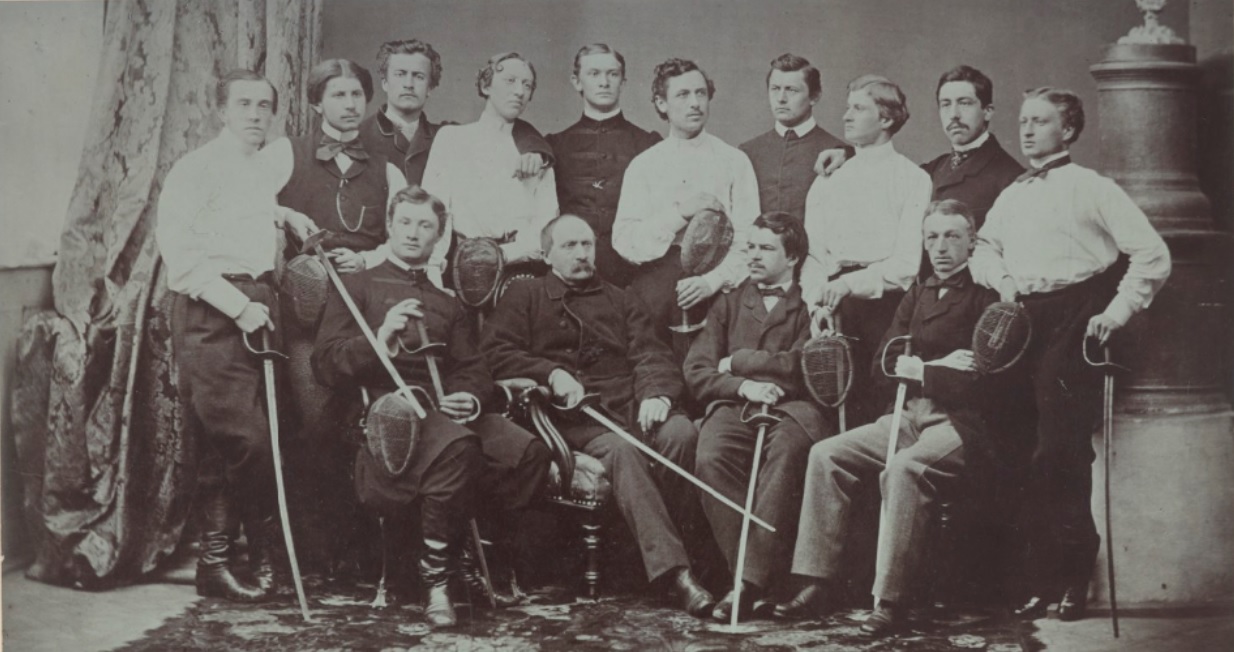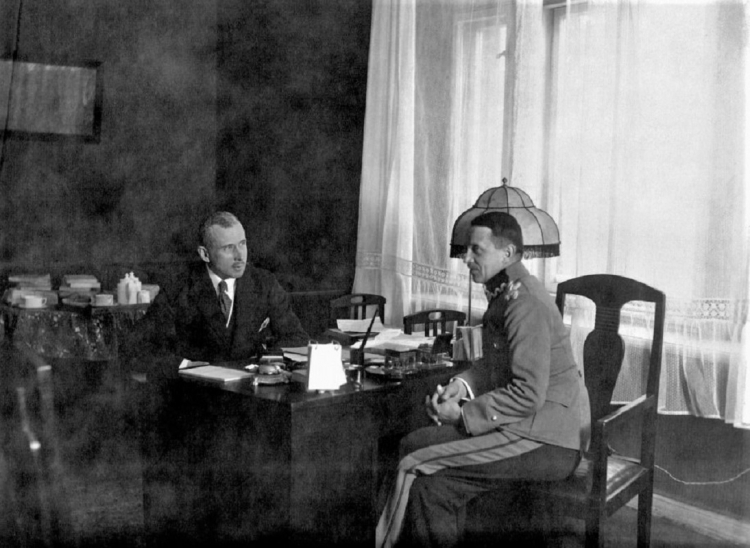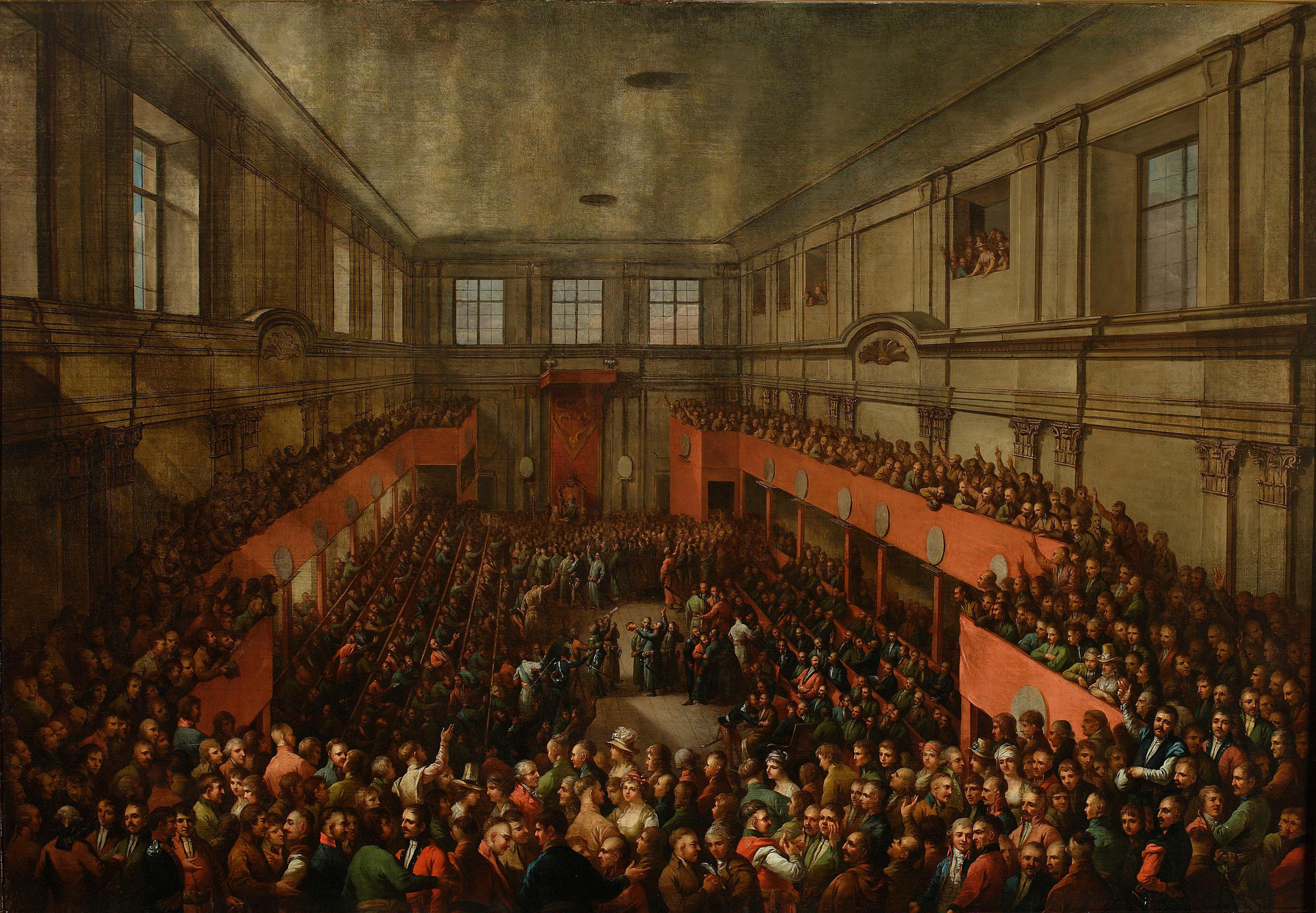Fighting with the sabre and bayonet was still part of military training in the 19th century. On the other hand, experienced soldiers were eager to pass on their skills to civilians in schools and private lessons. Fencing became a fashionable physical recreation, referring to the colourful history of Old Polish arms.
by Antoni Olbrychski
A handbook for soldiers
In 1827, a work entitled Nauka podająca sposoby bicia się na bagnety [trans: Learning how to Fight with Bayonets] was published in Warsaw. It contained information on stances, ways of moving, launching attacks or taking cover. The anonymous author also provided numerous tactical tips. He described how to defend oneself in the event of an attack from the front and from the flanks. He advised how to avoid becoming surrounded and in what formation it was best to repel an attack by cavalry armed with lances. The manual ran to over 350 pages and contained 52 engravings depicting fencing stances. It was therefore one of the most comprehensive pieces of Polish fencing literature of that era. On the other hand, it did not contain much information on sword fighting. The use of the backsword was mentioned only in the context of fighting against the bayonet.

Michał Starzewski aka the ‘Famous Backsword Fighter’
Michał Starzewski’s Traktat o szermierstwie [trans: A Treatise on Fencing] is considered to be the first Polish textbook describing methods of wielding the sabre. The author took part in the 1830-1831 November Uprising. He proved his sabre-fencing skills during numerous skirmishes. In 1839, he served as fencing master of Emperor Ferdinand’s First Cavalry Regiment. In 1849, he moved to Kraków, where, in agreement with municipal authorities, he tried to establish a public fencing school. The initiative failed. The fencer therefore began conducting private lessons. In 1857, he won a fencing tournament in Paris. In his old age, Starzewski settled in Tarnów. Fame preceded the fencing master at that time. Indeed, the Kurier Lwowski of 14 December 1886 reported of his move as follows: ‘Michał Starzewski, a Tarnów resident, a soldier in the 1831 November Uprising, a famous backsword fighter, has settled again in Tarnów after a 40-year absence (…). An old man, now 87, when he takes a backsword in his hand, his youthful strength returns.’
Starzewski did not manage to publish the Treatise before his death, and it was only his grandson who decided to do it in 1932. However, the textbook is problematic for researchers. The colourful, literary language full of anecdotes does not make it easy to understand the fencing activities described in it. Noteworthy is the use of Polish terminology. For example, cuts were divided into in-arm (those inflicted on the arms) and core (i.e. those delivered to the head and trunk). Starting stances, on the other hand, were defined as assault, hitting, offensive or reverse ones. These types of terms do not appear in other works on fencing. Starzewski’s Treatise is thus one of the most original works.
Antoni Durski: a populariser
In the 19th century, the Sokół (i.e. Falcon) Gymnastic Societies were established throughout Poland. Their aim was to promote physical culture. Fencing was very popular at the time, so it was obviously part of the Society’s activities offer. In the late 19th century, the Lwów branch of Sokół was headed by Antoni Durski. In 1879, he wrote a textbook entitled Szkoła szermierki siecznej [trans: The School of Cutting Fencing]. He devoted much attention to the description of equipment. The fencer’s equipment consisted of a weapon (defined as a ‘backsword, sabre, sword or spadroon’), a thick leather glove, a cloth sleeve (reaching up to the shoulder), a leather breastplate, and a wire mask. The handbook included instructions for the starting stance, cuts, covers and lean-on assaults. However, it made no mention of footwork, which is, after all, the basis of fencing. He only described the distance at which fencers should position themselves. It is possible that Durski simply did not have time to finish his manual. The last page ends with the sentence ‘On full-body fencing later’. Despite its small size (30 pages), the book is an invaluable source of learning about the old Polish style of sabre wielding. It must be emphasised that all the terminology is provided in Polish (e.g. covers, scrapes, pre-cuts, double-cuts). However, the nomenclature used by Durski does not coincide with that proposed by Starzewski.

Aleksander Raciborski: a scientist
In 1894, Dr Aleksander Raciborski, a lecturer at the John Casimir University in Lwów and president of the Fencing Society, published a work entitled Historia i psychologia szermierki [trans: The History and Psychology of Fencing]. In it, he presented the history of fencing from ancient times to his day. Unlike Starzewski and Durski, who have already been cited, he was not concerned with technical issues, such as cuts or blockouts. Instead, he produced an analysis of the temperaments and styles of fencers. He wrote: ‘A sanguine person will be quick to spot betrayals and vigorously act on them with parade and retort. The phlegmatic is often too late to parry and too lazy to retort, so [he] is a bad fencer in general. The choleric is a frequently threatening and dangerous handyman rather than a fencer. The melancholic often has correct and proper movements, but his game is nevertheless shaky at times, his attack not firm enough, his retort late and soft.’ Knights’ exercises, including fencing according to Raciborski, were meant to be a remedy for the ills of modern times, such as poor health and laziness.
Karol Bernolak: a tactician
In 1898, Podręcznik szermierczy i krótki opis szabli polskiej [trans: A Fencing Manual and a Short Description of the Polish Sabre] was published in Przemyśl. Its author was Karol Bernolak, a certified teacher of fencing and gymnastics. He used Polish terminology, but juxtaposed it with German and Italian, and sometimes English and French. Some names overlapped with those proposed by Durski. The system proposed by Bernolak was complete and clear. It included descriptions of stances, footwork, assaults, covers, counterattacks, spikes (strikes on the opponent’s blade) and disarms. Tactical advice was also a valuable addition. The author advised, for example, on how to defeat an opponent not skilled in the art of fencing. According to Bernolak, it was most advantageous to take cover and respond the moment the opponent betrayed signs of fatigue. If the opponent was attacking broadly, a counterattack on the arm should be attempted. A strong blow to the adversary’s blade could in turn lead to disarmament.

According to Bernolak, practising fencing was also an expression of patriotism. Deprived of their own statehood, Poles cultivated the traditions of their ancestors this way. He wrote: ‘One can only wish that the descendants of the knightly fathers, the heirs to their fame and misery, remember the art of fencing in a traditional way, mindful of its development of strength and dexterity, awakening of self-confidence and offering of encouragement in critical moments.’
Finally, it is worth mentioning the supporters of the Italian school. These included Kazimierz Bryła, the author of Szermierz postępowy, czyli podręcznik polski do nauki szermierki szpadonem [trans: The Progressive Fencer, i.e. a Polish Manual for Learning how to Wield the Spadroon] published in 1888, and Józef Żytny who wrote Krótki zarys szermierki na szabły podług metody włoskiej [trans: A Brief Outline of Sabre Wielding Following the Italian Method] published in 1900. Italian methodology and terminology reached the peak of popularity at the beginning of the following century. During a show in 1926, fencing master Henryk Bobkowski explained to the audience that the ‘Italian school is now in use, which is gradually replacing other schools’.
Author: Antoni Olbrychski
Translation: Mikołaj Sekrecki





